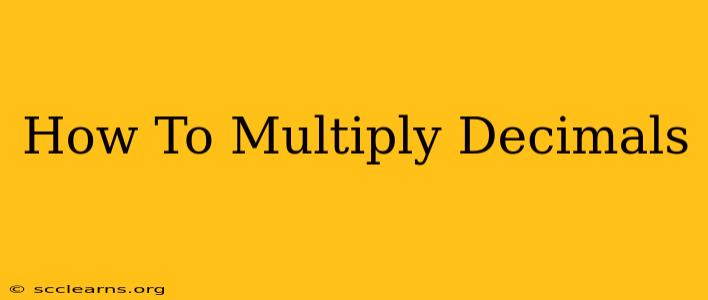Multiplying decimals might seem daunting at first, but with a clear understanding of the process, it becomes straightforward. This guide breaks down how to multiply decimals, offering practical examples and tips to master this essential math skill.
Understanding the Basics of Decimal Multiplication
Before diving into the steps, let's refresh our understanding of decimals. Decimals represent numbers less than one and are written with a decimal point separating the whole number part from the fractional part. For example, in the number 3.14, '3' is the whole number and '.14' is the fractional part.
The key to multiplying decimals lies in treating them initially as whole numbers, performing the multiplication, and then adjusting the decimal point in the final answer.
Step-by-Step Guide to Multiplying Decimals
Follow these steps to accurately multiply decimals:
Step 1: Ignore the Decimal Points
Initially, disregard the decimal points in both numbers. Treat them as whole numbers and perform the multiplication as you would with whole numbers.
Example: Let's multiply 2.5 by 1.2
Ignore the decimal points: 25 x 12
Step 2: Perform Standard Multiplication
Now, perform the standard multiplication process. You can use the traditional method or any other method you're comfortable with.
25
x 12
----
50
250
----
300
Step 3: Count the Decimal Places
Count the total number of decimal places in both original numbers. In our example:
- 2.5 has one decimal place (the '5' after the decimal point).
- 1.2 has one decimal place (the '2' after the decimal point).
Therefore, the total number of decimal places is 1 + 1 = 2.
Step 4: Place the Decimal Point
In the final answer (300 in our example), count from right to left the number of decimal places you calculated in Step 3. Place the decimal point accordingly.
In our example, we need to place the decimal point two places from the right: 3.00 (or simply 3).
Therefore, 2.5 x 1.2 = 3.
Multiplying Decimals with More Than One Decimal Place
The process remains the same, even when dealing with numbers having more decimal places.
Example: Multiply 3.14 by 2.7
- Ignore decimal points: 314 x 27
- Multiply:
314
x 27
-----
2198
6280
-----
8478
- Count decimal places: 3.14 (2 decimal places) + 2.7 (1 decimal place) = 3 decimal places
- Place decimal point: 8.478
Therefore, 3.14 x 2.7 = 8.478
Practical Applications and Tips for Success
Mastering decimal multiplication is crucial for various applications in everyday life and various fields, including:
- Financial calculations: Calculating discounts, taxes, and interest.
- Scientific measurements: Working with units like meters, liters, and grams.
- Engineering and design: Precise calculations for building and construction.
Remember these helpful tips:
- Practice regularly: The more you practice, the more comfortable you'll become.
- Use estimation: Before calculating, estimate the answer to check for reasonableness.
- Check your work: Carefully review your steps to minimize errors.
By following these steps and practicing regularly, you'll confidently tackle any decimal multiplication problem. Remember, the key is to break the process down into manageable steps, and you'll master this important mathematical skill in no time!

